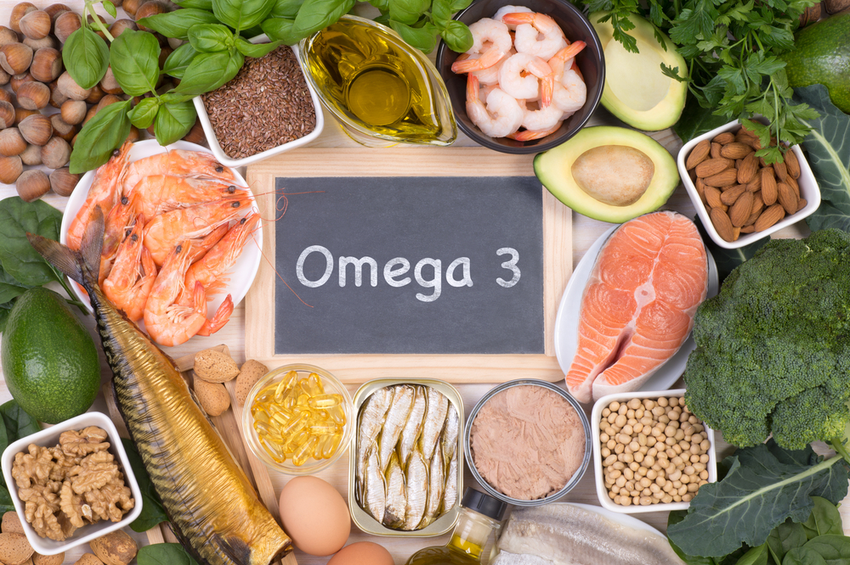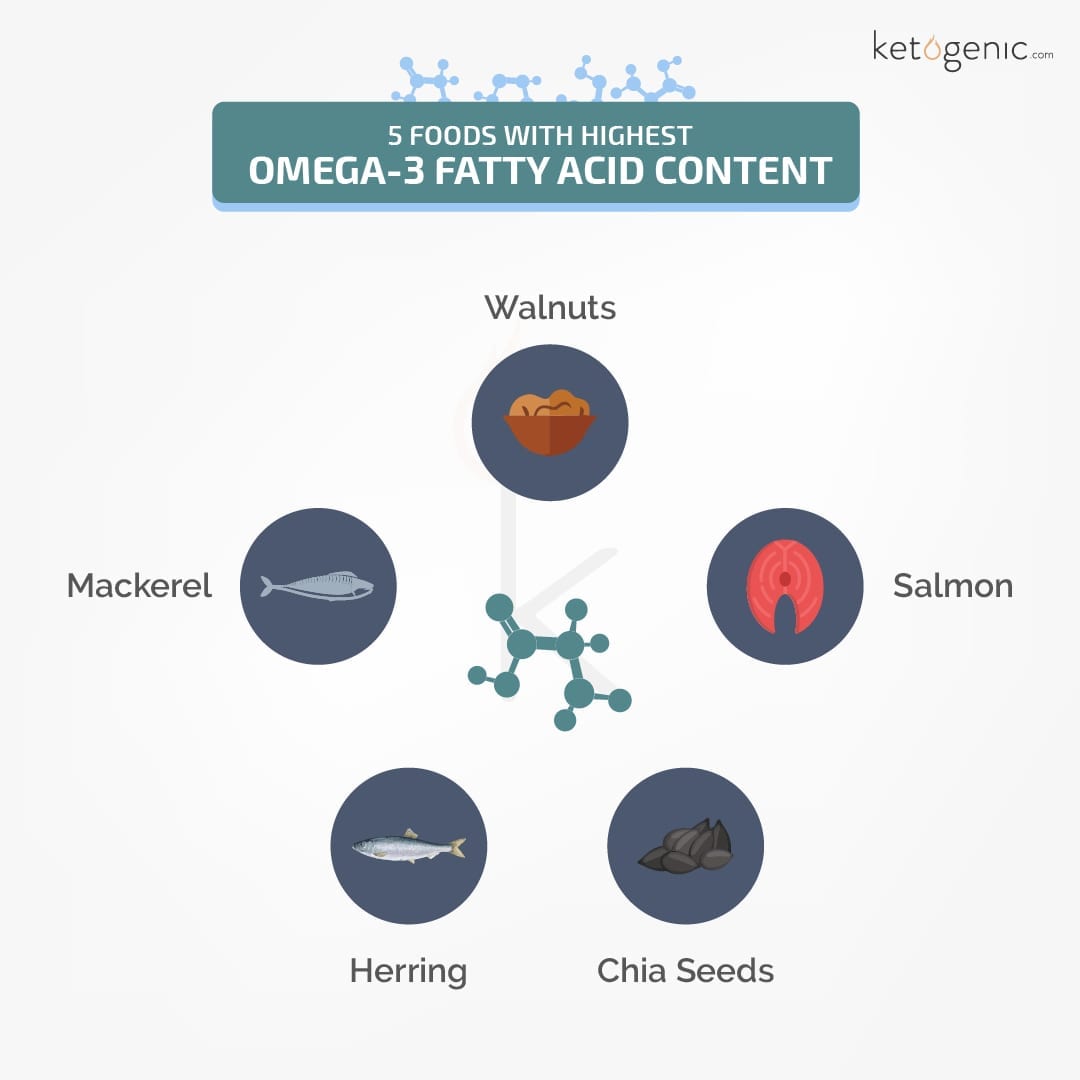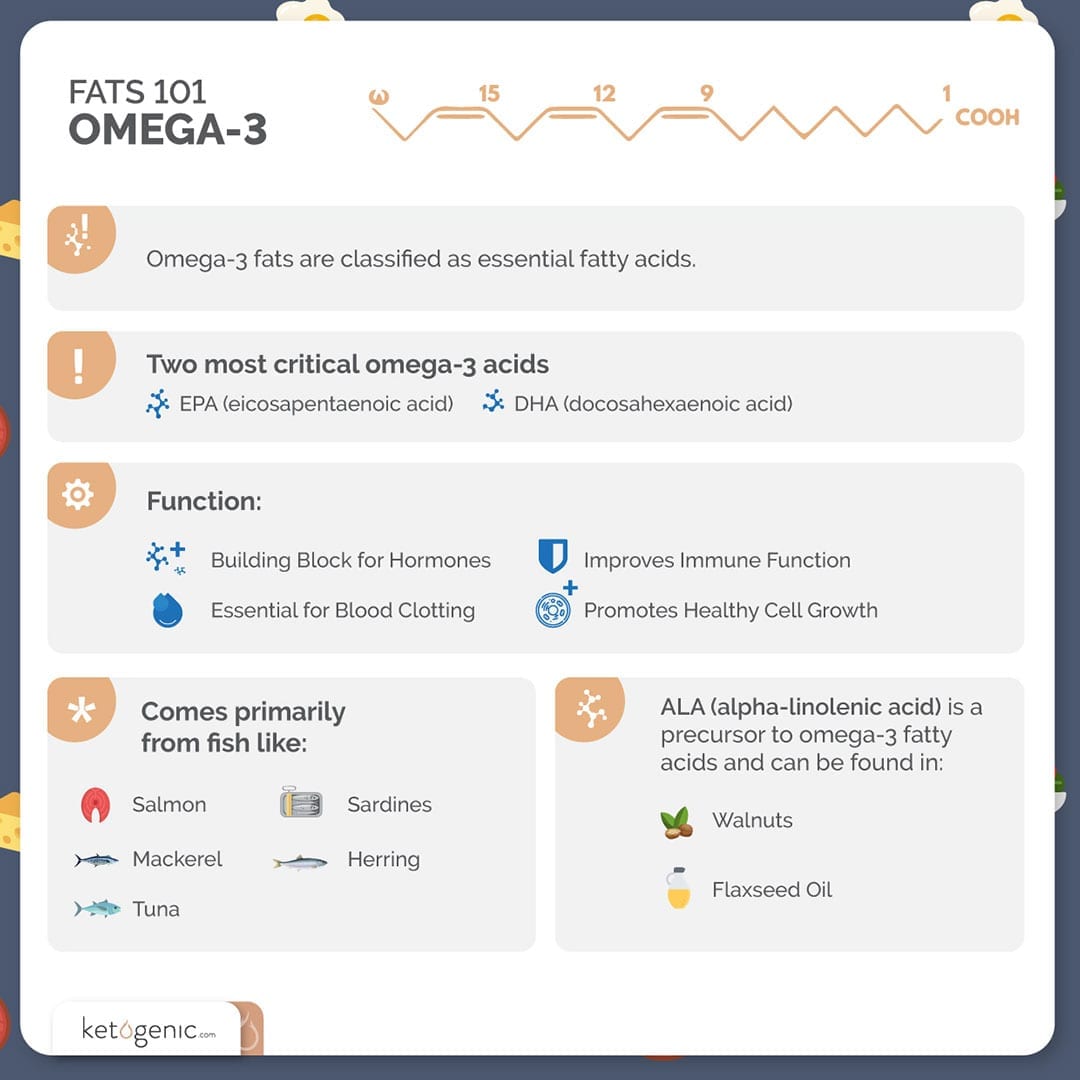Breaking Down Omega-3 Fatty Acids: EPA, DHA, and ALA

Boost your health with omega-3 fatty acids! You’ve heard all the fuss about omega-3 fatty acids and the health benefits that come along with them. Of the 11 different omega-3s, the three most important are DHA, EPA, and ALA. Let’s break down the benefits, the differences, and how it ties in with your ketogenic diet!
What are Omega-3 Fatty Acids?
Omega-3s are deemed essential polyunsaturated fatty acids because your body can’t make them, but they’re essential for health. This means you have to obtain these fatty acids from your diet. These fatty acids are used for important roles in various bodily processes, including heart health, inflammation, and brain function.
The three widely discussed omega-3 fatty acids are EPA, DHA, and ALA. ALA is mostly found in plants, and EPA and DHA are found mostly in animal foods, such as fatty fish.
Omega-3 deficiency is linked to depression, heart disease, cancer, arthritis, lower intelligence, and more. [1] [2]

ALA (alpha-linolenic acid)
The most common omega-3 fatty acid in a standard American diet is ALA or alpha-linolenic acid. ALA is a necessary precursor of EPA or DHA, and it’s typically present in plant foods like kale, spinach, soybeans, walnuts, and seeds like chia and flax. It’s also present in some animal fats. Seed oils like canola (rapeseed) and flaxseed oil have a high content of ALA.
In humans, this conversion process is inefficient, and only a minor percentage of ALA is actually converted to EPA and even less into DHA. ALA that isn’t converted to DHA or EPA is stored or used as energy. [3] [4] [5]
Observational studies have associated a diet high in ALA with a reduced risk of death from heart disease. On the other hand, some studies show an increased rate of prostate cancer. [6]
The heightened prostate cancer risk wasn’t linked to the other main omega-3 types, DHA and EPA, which actually seem to be protective against prostate cancer. More studies are needed to obtain a clearer conclusion. [7]
EPA (eicosapentaenoic acid)
Chronic low-level inflammation is a known driver of several diseases. Your body uses EPA or eicosapentaenoic acid to produce signaling molecules that reduce inflammation. [8] [9]
You’ve probably heard people talking about fish oil for lowering inflammation and helping with a plethora of ailments. Fish oil is rich in omega-3 fatty acids (EPA and DHA) which might reduce symptoms of depression. Evidence points to EPA being superior to DHA when it comes to depression. [10] [11]
DHA and EPA are primarily found in seafood, including algae and fatty fish. Salmon, eel, sturgeon, shrimp, and herring contain some of the highest concentrations of EPA. Grass-fed animal products like meats and dairy contain some EPA.

DHA (docosahexaenoic acid)
DHA or docosahexaenoic acid is a key structural component of the retinas in your eyes and your skin. DHA is crucial for childhood brain development and function and adult brain function, and it’s been shown to improve vision in infants. [12] [13]
DHA deficiency in early life is associated with problems further down the road, such as ADHD, aggressive hostility, and learning difficulties. [14]
Decreased DHA later in life is associated with the onset of Alzheimer’s disease and impaired brain function. [15]
DHA might exhibit positive effects on conditions like arthritis, some cancers, high blood pressure, and type 2 diabetes. DHA might also boost heart health and improve cholesterol. [16] [17] [18]
You can find DHA in high concentrations of seafood, including fatty fish and algae. Some DHA is present in grass-fed animal products.

Conversions
The most common omega-3 essential fatty acid, ALA, is converted into DHA and EPA, but this conversion process is inefficient in humans. On average, only an estimated 0.5-5% is converted into DHA and only 1-10% into EPA. [19]
Interestingly, the conversion rate depends on sufficient levels of nutrients like calcium, magnesium, copper, iron, zinc, and vitamins B6 and B7. A modern diet, and often a vegetarian diet, lack some of these nutrients. [20]
The conversion process requires certain enzymes. Omega-6 fatty acids need these same enzymes. The modern diet is usually high in omega-6s, which might reduce the conversion of ALA to DHA and EPA. A lack of calories and protein can also interfere with the enzymes responsible for the ALA conversion.
In Conclusion
ALA exists in certain high-fat plant foods like flax seeds, walnuts, and chia seeds. Your body can convert ALA to EPA and DHA, but this conversion process is inefficient.
EPA and DHA are considered the most important omega-3s, and these are primarily found in fish oil, seafood, omega-3 enriched or pastured eggs, fatty fish and algae, and meat and dairy from grass-fed animals. You might decide to supplement if you don’t eat enough of these foods, though most ketogenic diets include these foods. If you’re a vegetarian or vegan, you might choose algal oil. You can find a range of omega-3 supplements in stores or online.
References
Ruxton, C. H. S., Reed, S. C., Simpson, M. J. A., & Millington, K. J. (2004). The health benefits of omega-3 polyunsaturated fatty acids: A review of the evidence. Journal of Human Nutrition and Dietetics, https://doi.org/10.1111/j.1365-277X.2004.00552.x
Leaf, A. (2007). Prevention of sudden cardiac death by n-3 polyunsaturated fatty acids. J Cardiovasc Med (Hagerstown), DOI: 10.2459/01.JCM.0000289270.98105.b3
Gerster, H. (1998). Can adults adequately convert alpha-linolenic acid (18:3n-3) to eicosapentaenoic acid (20:5n-3) and docosahexaenoic acid (22:6n-3)? Int J Vitam Nutr Res, 68(3), 159-73.
Burdge, G. C. (2006). Metabolism of alpha-linolenic acid in humans. Prostaglandins Leukot Essent Fatty Acids, 75(3), 161-8. DOI: 10.1016/j.plefa.2006.05.013
Plourde, M., & Cunnane, S. C. (2007). Extremely limited synthesis of long chain polyunsaturates in adults: Implications for their dietary essentiality and use as supplements. Appl Physiol Nutr Metab, 32(4), 619-34. DOI: 10.1139/H07-034
Brouwer, I. A., Katan, M. B., & Zock, P. L. (2004). Dietary alpha-linolenic acid is associated with reduced risk of fatal coronary heart disease, but increased prostate cancer risk: A meta-analysis. Journal of Nutrition, 134(4), 919-22. DOI: 10.1093/jn/134.4.919
Leitzmann, M. F., Stampfer, M. J., Michaud, D. S., Augustsson, K., Colditz, G. C., Willett, W. C., & Giovannucci, E. L. (2004). Dietary intake of n-3 and n-6 fatty acids and the risk of prostate cancer. American Journal of Clinical Nutrition, 80(1), 204-16. DOI: 10.1093/ajcn/80.1.204
Ricciotti, E., & FitzGerald, G. A. (2011). Prostaglandins and inflammation. Arterioscler Thromb Vasc Biol, 31(5), 986-1000. DOI: 10.1161/ATVBAHA.110.207449
Sierra, S., Lara-Villoslada, F., Comalada, M., Olivares, M., & Xaus, J. (2008). Dietary eicosapentaenoic acid and docosahexaenoic acid equally incorporate as docosahexaenoic acid but differ in inflammatory effects. Nutrition, 24(3), 245-54. DOI: 10.1016/j.nut.2007.11.005
Mozaffari-Khosravi, H., Yassini-Ardakani, M., Karamati, M., & Shariati-Bafghi, S. (2013). Eicosapentaenoic acid versus docosahexaenoic acid in mild-to-moderate depression: A randomized, double-blind, placebo-controlled trial. Eur Neuropsychopharmacol, 23(7), 636-44. DOI: 10.1016/j.euroneuro.2012.08.003
Martins, J. G. (2009). EPA but not DHA appears to be responsible for the efficacy of omega-3 long chain polyunsaturated fatty acids supplementation in depression: Evidence from a meta-analysis of randomized controlled trials. Journal of the American College of Nutrition, 28(5), 525-42. DOI: 10.1080/07315724.2009.10719785
Singh, M. (2005). Essential fatty acids, DHA, and human brain. The Indian Journal of Pediatrics, (72), 239-242. 13.
Tai, E. K. K., Wang, X. B., & Chen, Z-Y. (2013). An update on adding docosahexanoic acid (DHA) and arachidonic acid (AA) to baby formula. Food Funct, 4(12), 1767-75. DOI: 10.1039/c3fo60298b 14.
Agostoni, C., Trojan, S., Bellu, R., Riva, E., Bruzzese, M. G., & Giovannini, M. (1997). Developmental quotient at 24 months and fatty acid composition of diet in early infancy: A follow up study. Arch Dis Child, 76(5), 421-4. DOI: 10.1136/adc.76.5.421 15.
Mohajeri, M. H., Troesch, B., & Weber, P. (2015). Inadequate supply of vitamins and DHA in the elderly: Implications for brain aging and Alzheimer-type dementia. Nutrition, 31(2), 261-75. DOI: 10.1016/j.nut.2014.06.016 16.
Horrocks, L. A., & Yeo, Y. K. (1999). Health benefits of docosahexaenoic acid (DHA). Pharmacol Res, 40(3), 211-25. DOI: 10.1006/phrs.1999.0495 17.
Li, Q., Wang, M., Tan, L., Wang, C., Ma, J., Li, N., Li, Y, Xu, G., & Li, J. (2005). Docosahexaenoic acid changes lipid composition and interleukin-2 receptor signaling in membrane rafts. J Lipid Res, 46(9), 1904-13. DOI: 10.1194/jlr.M500033-JLR200 18.
Chapkin, R, S., McMurray, D. N., Davidson, L. A., Patil, B. S., Fan, Y-Y., & Lupton, J. R. (2009). Bioactive dietary long chain fatty acids: Emerging mechanisms of action. British Journal of Nutrition, 100(6), 1152-1157. DOI: 10.1017/S0007114508992576 19.
Burdge, G. C., & Wootton, S. A. (2002). Conversion of alpha-linolenic acid to eicosapentaenoic, docosapentaenoic, and docosahexaenoic acids in young women. British Journal of Nutrition, 88(4), 411-20. DOI: 10.1079/BJN2002689 20.
Davis, B. C., & Kris-Etherton, P. M. (2003). Achieving optimal essential fatty acid status in vegetarians: Current knowledge and practical implications. American Journal of Clinical Nutrition, 78(3 Suppl), 640S-646S. DOI: 10.1093/ajcn/78.3.640S









